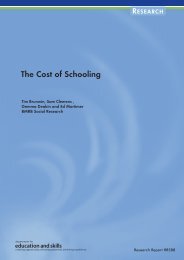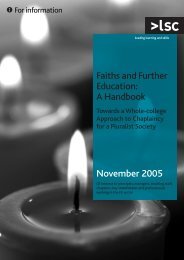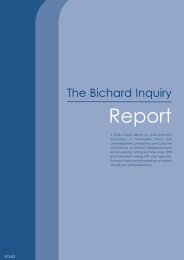Recognising and recording progress and achievement in non ...
Recognising and recording progress and achievement in non ...
Recognising and recording progress and achievement in non ...
You also want an ePaper? Increase the reach of your titles
YUMPU automatically turns print PDFs into web optimized ePapers that Google loves.
<strong>Recognis<strong>in</strong>g</strong> <strong>and</strong> Record<strong>in</strong>g Progress <strong>and</strong> Achievement <strong>in</strong> Non-accredited Learn<strong>in</strong>gThe quality of such programmes can be assuredby sampl<strong>in</strong>g tutor records, teach<strong>in</strong>g <strong>and</strong> learn<strong>in</strong>gobservation records or other suitable approachesthat will provide the assurance the learn<strong>in</strong>g providerfeels is appropriate to these programmes.Learner is at the centre <strong>and</strong> enhance the learners’experience39 The evaluation of the pilot projects clearlydemonstrated that RARPA benefits learners <strong>and</strong>enhances learn<strong>in</strong>g. By focus<strong>in</strong>g on the learner,the staged process engages tutors <strong>in</strong> an ongo<strong>in</strong>gdialogue about the learner’s learn<strong>in</strong>g <strong>and</strong> ensures thatthe personal aims <strong>and</strong> motivation of the learnercan be accommodated by the learn<strong>in</strong>g programme.Non-accredited learn<strong>in</strong>g does not normally havethe formal syllabus content or assessment criteriaof accredited learn<strong>in</strong>g. This has to be providedby the tutor <strong>and</strong> supported by the learn<strong>in</strong>g provider.The personal reasons the learner has for participat<strong>in</strong>g<strong>in</strong> the learn<strong>in</strong>g activity become central to their <strong>progress</strong><strong>and</strong> successful outcomes to learn<strong>in</strong>g. The staged processcaters for this <strong>and</strong> also for identify<strong>in</strong>g learn<strong>in</strong>goutcomes that were not expected at the startof the programme <strong>and</strong> which, when recorded,also <strong>in</strong>dicate that the learner has had a successfullearn<strong>in</strong>g experience.Complement <strong>and</strong> <strong>in</strong>tegrate with exist<strong>in</strong>g processes40 RARPA should not create additional systemsor <strong>record<strong>in</strong>g</strong>. Providers are already expected to collectsufficient <strong>in</strong>formation about the learn<strong>in</strong>g they offer,accredited <strong>and</strong> <strong>non</strong>-accredited, to <strong>in</strong>form their selfassessment<strong>and</strong> quality improvement activities.Inspection f<strong>in</strong>d<strong>in</strong>gs <strong>in</strong>dicate that whilst many providersare <strong>in</strong> this position, there are still unsatisfactorycontributory grades for quality assurance,<strong>and</strong> weaknesses <strong>in</strong> quality improvement. Where thisis the case, providers need to improve their qualityassurance processes to the position the LSC<strong>and</strong> <strong>in</strong>spectorates expect them to have reached,ensur<strong>in</strong>g that all learn<strong>in</strong>g is valued <strong>and</strong> evaluated.Further <strong>in</strong>formation can be found <strong>in</strong> QualityImprovement <strong>and</strong> Self-assessment (LSC, 2005)(www.lsc.gov.uk/National/Documents/Read<strong>in</strong>gRoom/default.htm).New Common Inspection Framework41 Under the new Common Inspection Framework(CIF), <strong>in</strong>spection will place more emphasis on check<strong>in</strong>gthe capacity of providers to accurately assurethe quality of their provision <strong>and</strong> improve or ma<strong>in</strong>ta<strong>in</strong>st<strong>and</strong>ards. The self-assessment report <strong>and</strong> qualityimprovement plan will be key evidence for this.42 Under the new <strong>in</strong>spection arrangements, two newoverall judgements will be made:• ‘the overall effectiveness of the provision,<strong>in</strong>clud<strong>in</strong>g any extended services, <strong>and</strong> its ma<strong>in</strong>strengths <strong>and</strong> weaknesses• the capacity to make further improvements.’43 Providers need to ensure that their selfassessmentreports <strong>and</strong> mechanisms for <strong>record<strong>in</strong>g</strong>learners’ <strong>progress</strong> <strong>and</strong> success are comprehensive,consistent <strong>and</strong> effective. The application of RARPAwill help to achieve this.44 Further <strong>in</strong>formation about RARPA <strong>and</strong> the newCommon Inspection Framework can be found<strong>in</strong> paragraphs 49 to 53.The Application ofRARPA45 The RARPA approach will be <strong>in</strong>troduced acrossLSC-funded <strong>non</strong>-accredited provision from September2005. From this date, providers receiv<strong>in</strong>g LSC fundsfor <strong>non</strong>-accredited provision will be expected to have<strong>in</strong> place a plan for implement<strong>in</strong>g RARPA across suchprovision dur<strong>in</strong>g 2005-06. This will be summarisedthrough a statement about the implementationof RARPA <strong>in</strong> providers’ three-year development plans.46 2005-06 is an embedd<strong>in</strong>g year for RARPA.Providers are not expected to have fully implementedthe approach <strong>in</strong> September 2005 but to develop theirprocesses so that the self-assessment report for2005-06 covers all learn<strong>in</strong>g, accredited<strong>and</strong> <strong>non</strong>-accredited, <strong>and</strong> that RARPA then formspart of the normal quality cycle for the provider.47 From September 2006, all providers receiv<strong>in</strong>g LSCfund<strong>in</strong>g will be expected to apply the RARPA approach<strong>in</strong> full to <strong>non</strong>-accredited provision.48 The actions that providers need to take are to:• ensure the quality assurance processes,self-assessment <strong>and</strong> quality improvementplann<strong>in</strong>g <strong>in</strong>clude all provision, accredited<strong>and</strong> <strong>non</strong>-accredited• review teach<strong>in</strong>g <strong>and</strong> learn<strong>in</strong>g strategiesfor <strong>non</strong>-accredited learn<strong>in</strong>g to ensure thatthe staged process can be applied to teach<strong>in</strong>gpractices <strong>in</strong> a way that ensures the stagedprocess is be<strong>in</strong>g applied to the benefitof learners6
















